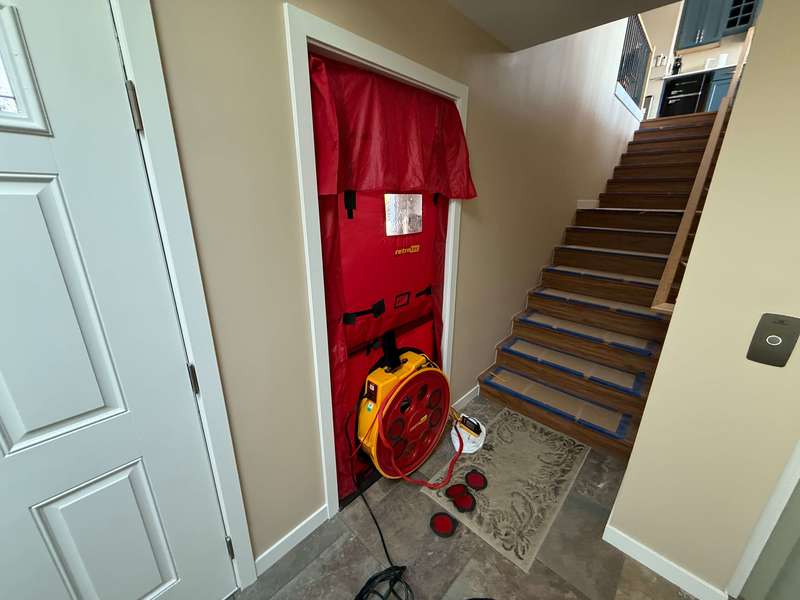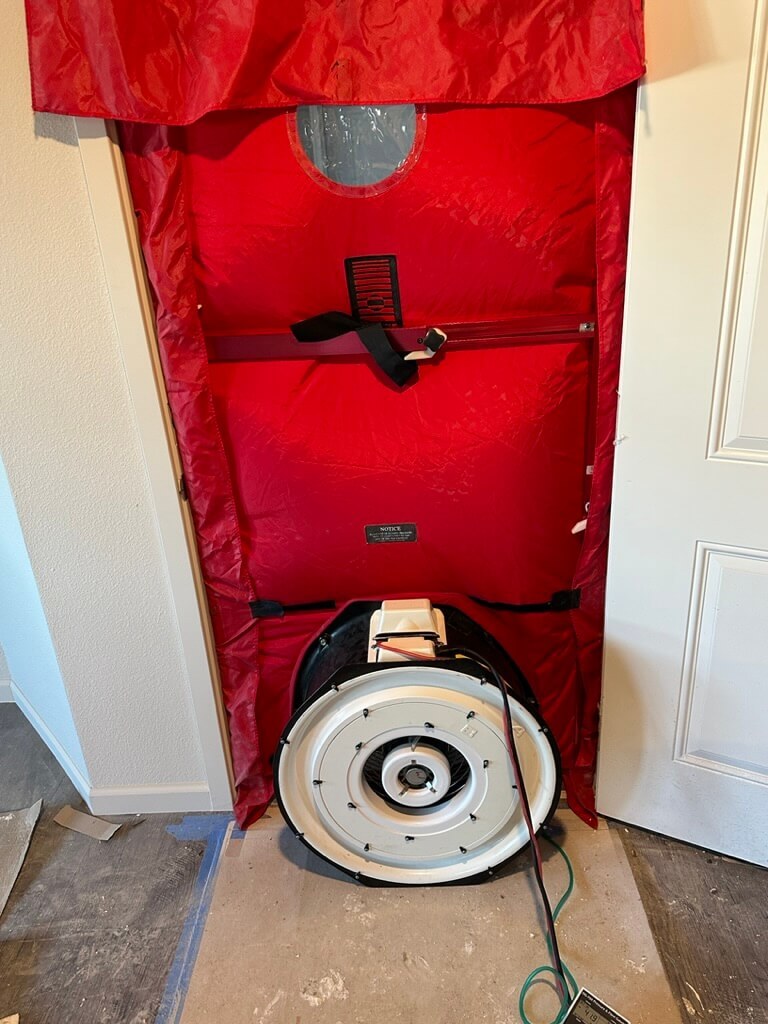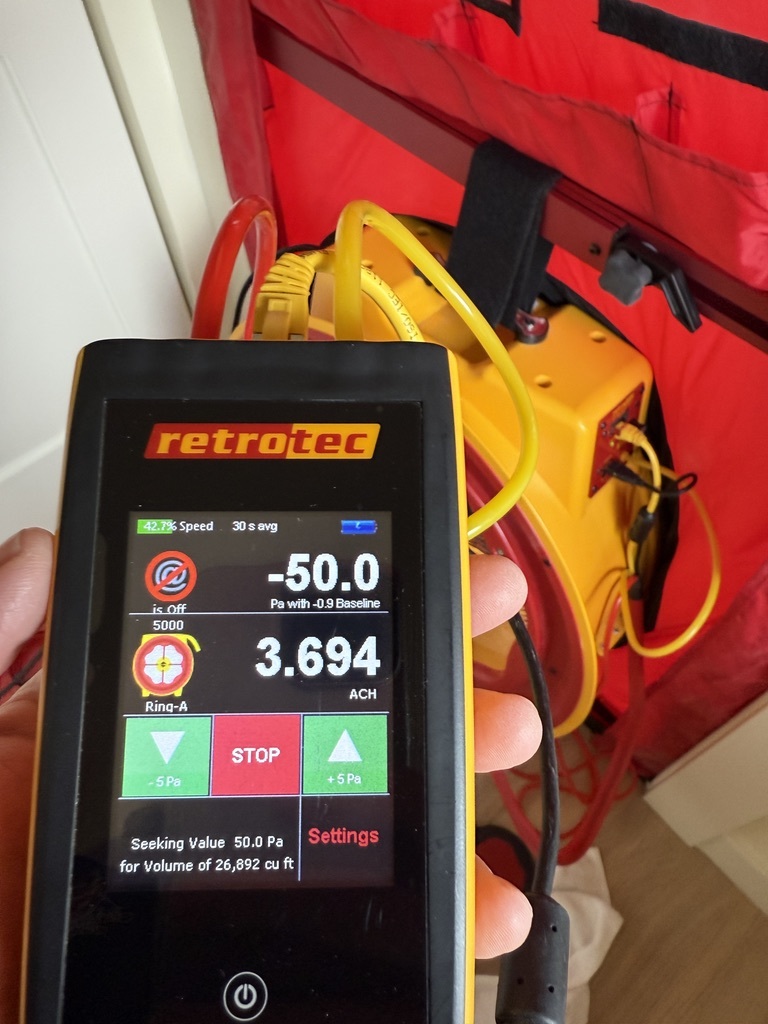Commercial Blower Door Testing
Typically, blower door tests for energy compliance in residential and commercial buildings are performed with a 50 Pa pressure difference (ACH50). However, there are instances when 75 Pa might be required instead of the usual 50 Pa for specific tests. Here’s when 75 Pa might come into play:
Mandatory 75 Pa Testing for Specific Scenarios:
-
When Testing Common Areas in Multi-Unit Buildings: In some situations, common areas or shared spaces in multi-unit residential buildings might be tested at a higher pressure difference (75 Pa) to ensure more accurate air leakage measurement. For example, in multi-family housing where the common walls or ceilings are shared between units, the test might use 75 Pa to measure air leakage more rigorously. The 75 Pa level ensures that the test is more reflective of potential leaks between individual units, as well as between the building’s exterior and interior.
-
Ventilation and HVAC Systems: Some local building codes may require 75 Pa to test mechanical ventilation systems, including ducts and exhaust systems, to ensure that the system is airtight and functioning efficiently.
-
Special Conditions or Retrofits: For existing buildings undergoing retrofits or upgrades, or where there’s concern about high air leakage rates, 75 Pa might be used to apply more pressure to see if there are leaks that wouldn't normally show up under 50 Pa testing. This is especially the case when you suspect potential air transfer between units (which could result in noise, moisture problems, or energy inefficiency).
When 75 Pa is Used in Commercial or Larger Buildings:
-
For Commercial and Non-Residential Buildings: For larger commercial buildings or other non-residential buildings, 75 Pa is often used as a baseline for air barrier testing. It's a more common standard in commercial construction to assess the integrity of the air barrier, including windows, doors, and other exterior envelope components.
-
Specific Code Compliance: The 75 Pa pressure difference is sometimes used to assess building tightness for commercial projects under both WSEC and ASHRAE standards (particularly ASHRAE 90.1 for commercial buildings). This higher pressure helps simulate more demanding conditions to identify vulnerabilities.
Code References for 75 Pa:
-
International Energy Conservation Code (IECC): The IECC, which has influenced the Washington State Energy Code, allows for both 50 Pa and 75 Pa tests depending on the type of system being evaluated. In certain circumstances, the code allows for 75 Pa to be used for systems that require higher-pressure testing, like large duct systems or buildings with complex ventilation systems.
-
Washington State Energy Code (WSEC): As of the most recent updates to the WSEC, it follows the IECC’s general guidelines, but specific references to 75 Pa may apply in situations where a higher pressure differential is necessary for thorough testing or in areas that demand greater energy conservation measures.
Air Leakage and Pressure Differences:
-
50 Pa vs. 75 Pa: The difference between 50 Pa and 75 Pa is that the higher pressure helps force air through smaller, harder-to-detect leaks. 50 Pa is typically sufficient for residential buildings, but 75 Pa might reveal leaks that are only noticeable under more extreme pressure conditions.
-
Effect on ACH Values: When testing at 75 Pa, the building will often appear to have a slightly higher air leakage rate compared to tests at 50 Pa. This is important because it gives a better sense of the maximum potential leakage in a building, particularly for larger or more complex structures.
Blower Door Testing FAQ for Multi-Unit Buildings and 75 Pa Pressure
1. What is Blower Door Testing?
Blower door testing is a diagnostic tool used to measure the airtightness of a building. A large fan is placed in an exterior door to depressurize the building, and the amount of air leakage is measured. The test is used to ensure the building meets the required air tightness standards set by building codes like the Washington State Energy Code (WSEC).
2. What is the standard pressure difference used for blower door testing?
The standard pressure used in most blower door tests is 50 Pascals (Pa). This is typically used for residential buildings, including multi-unit buildings, to measure the air leakage rate of the building’s envelope. However, in some cases, 75 Pa may be required, especially for specific conditions or building systems.
3. When is 75 Pa required in blower door testing?
75 Pa may be required in the following situations:
-
For testing multi-unit residential buildings with shared walls or common spaces (such as hallways or stairwells), where more rigorous testing is needed.
-
For mechanical ventilation systems, including ducts or exhaust systems, to ensure airtightness.
-
In commercial or non-residential buildings, where higher air leakage testing pressures are standard (such as for large HVAC systems or complex building envelopes).
-
When retrofitting existing buildings or addressing issues with air leakage in particularly tight spaces.
4. What is the difference between 50 Pa and 75 Pa pressure in testing?
The primary difference is the pressure differential applied during the test. Testing at 75 Pa applies more pressure to the building, which can identify smaller or harder-to-detect leaks that may not show up under 50 Pa testing. It gives a more demanding test, especially for large, complex, or multi-unit buildings.
5. How does the pressure change affect the test results?
-
At 50 Pa, the test gives a baseline air leakage rate, often used for residential buildings.
-
At 75 Pa, the air leakage rate typically appears slightly higher since it forces more air through any gaps, giving a more thorough understanding of the building's envelope performance. This helps uncover harder-to-detect leaks, especially in commercial or multi-unit spaces.
6. Does blower door testing with 75 Pa apply to all multi-unit buildings?
No, 75 Pa is generally applied in specific situations or where the building has certain features, like shared walls or more complex systems. For standard multi-unit residential buildings, 50 Pa is usually sufficient. However, if the building is a larger, more complex structure or if it's under renovation, 75 Pa may be used.
7. Is blower door testing mandatory in Washington State?
Yes, blower door testing is mandatory for most residential and commercial buildings in Washington State to ensure compliance with the Washington State Energy Code (WSEC). This helps verify that the building’s envelope is airtight, leading to energy savings, improved comfort, and better indoor air quality.
8. What happens if a building fails the blower door test?
If the building fails the blower door test (i.e., it exceeds the allowed air leakage rate), the building will need to be sealed or tightened further. This may involve adding or improving weatherstripping, sealing gaps around windows and doors, or addressing issues in the building’s mechanical systems (HVAC or ductwork).
9. How do I know if my building needs 75 Pa testing?
Check with your energy auditor or building professional to see if your building falls under the conditions that require 75 Pa testing. These might include multi-unit buildings with shared spaces, buildings with complex HVAC systems, or commercial structures that are subject to stricter energy performance standards.
10. Can I conduct the blower door test myself?
Blower door tests must be performed by a certified energy auditor or a professional who is trained and equipped with the necessary tools. The testing process requires specialized equipment and the expertise to interpret the results and ensure compliance with the energy code.
11. How is the test result reported?
The test results are reported as air changes per hour (ACH) at 50 Pa (ACH50) or 75 Pa, depending on the test conditions. This value tells you how many times the air within the building is replaced per hour due to leakage at a given pressure difference. A lower ACH value indicates better airtightness.
12. Is there a specific ACH target for multi-unit buildings?
Yes, most multi-unit buildings must meet an ACH50 value that is below a certain threshold to be considered compliant with the energy code. The typical allowable ACH50 is between 3 and 5 ACH depending on the building’s size, type, and purpose. If the result exceeds this value, remedial measures are required.



 For homes with forced-air heating or air conditioning, we offer comprehensive duct leakage inspections.
For homes with forced-air heating or air conditioning, we offer comprehensive duct leakage inspections.








 .
.  .
. 





 and flue dampers shall be closed, but not sealed beyond intended infiltration control measures.
and flue dampers shall be closed, but not sealed beyond intended infiltration control measures.
 .
. 




















